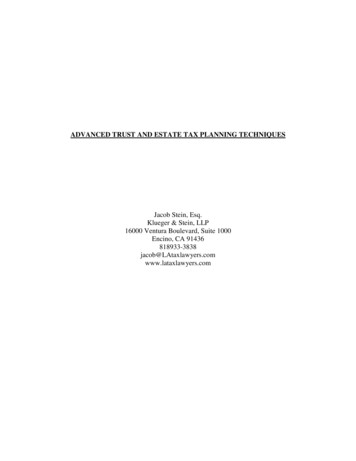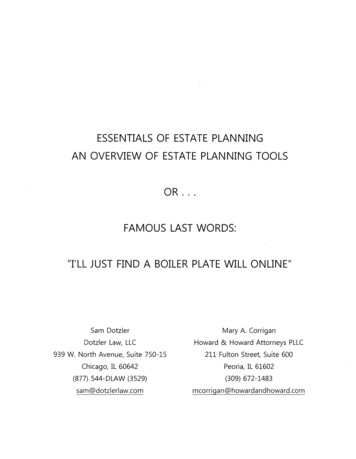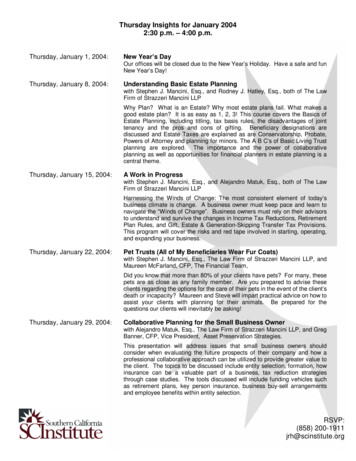
Transcription
Advanced Estate Planning TechniquesIntroductionBelow we have described what we call advanced estate planning techniques that clientsmay wish to consider once they have basic estate planning documents in place. The descriptionsbelow are not intended to be a discussion of all the technical requirements for each technique,but rather, a general description of the technique and how it works. If you would like to explorethe use of any of the techniques described below, a member of the trusts and estates departmentwould be happy to discuss the technique with you in detail and to prepare an analysis of how theparticular technique would operate in your overall plan.Qualified Personal Residence Trusts (“QPRT”)QPRTs are an estate planning technique specifically permitted under the InternalRevenue Code and Regulations. To use this technique, the grantor creates a trust to which he orshe transfers a residence. Under the terms of the trust, the grantor may use the residencecontributed to the trust for the trust term (the trust term chosen is designed to be shorter than thelife expectancy of the grantor). The trust terminates at the end of the trust term and the residencepasses either outright to the grantor’s children or, as we generally suggest, in further trust. Afterthe termination of the trust, the grantor may continue to have the use of the residence but he orshe is required to pay fair market rent in order to do so.Why QPRTs WorkQPRTs are effective because they allow the grantor to transfer a residence for less thanits full value. This is possible because, for gift tax purposes, the value of the gift to the trust isequal to the full value of the residence less the value of the right, retained by the grantor, to usethe residence during the trust term. In addition, the expectation is that the residence willappreciate faster than the interest rate prescribed by the Internal Revenue Service and theRegulations to determine the value of the interest retained by the grantor and the interesttransferred. As long as the grantor survives the trust term, both the value of the residence and allfuture appreciation are removed from the grantor’s estate.Having the residence pass to a trust at the end of the QPRT presents an opportunity foradditional estate planning benefits. If the continuing trust is structured as a grantor trust, undercurrent law, the rent paid by the grantor is not treated as income to the trust. The end result is Bleakley Platt & Schmidt, LLP 2012.Written by Michelle L. Orlowski, Of Counsel, Bleakley Platt & Schmidt, LLP.
that the rental payments made by the grantor for the continued use of the residence pass to thelower generation free of tax. There has been some discussion recently in Congress of changingthe grantor trust rules.CaveatsIf the Grantor does not survive the trust term, the value of the residence on the date of thegrantor’s death will be included as part of his or her estate for estate tax purposes. If the grantorpaid gift taxes in connection with the transaction, the grantor’s estate will receive a credit for gifttaxes attributable to the transaction.The grantor should be financially able to pay the rent for the residence, if the Grantorwishes to continue to occupy the residence after the initial trust term. If the rent is not paid, thebenefits of the transaction may be lost or reduced.The trust takes the owner’s basis in the residence therefore, the capital gains taxes thatwill be paid on the sale of the residence after the grantor’s death should be considered indetermining the overall tax savings to be obtained by the transaction.The Grantor will need to consider generation-skipping tax issues if the beneficiaries ofthe continuing trust may be grandchildren of the Grantor.Grantor Retained Annuity Trusts (“GRAT”)Like the QPRT, GRATs are specifically permitted under the Internal Revenue Code andRegulations. To use this technique, the grantor creates a trust to which he or she transfers anasset or several assets, such as stock, partnership interests, interests in real estate, etc. Under theterms of the trust, the grantor retains the right to annuity payments (fixed payments determinedbased on the value of the assets transferred to the trust on the date of transfer) for the trust term.At the end of the trust term, the trust terminates and the trust assets are distributed either outrightto the beneficiaries or to a continuing trust.Why GRATs WorkAs with the QPRT, GRATs are effective because they allow the grantor to transfer assetsfor less than the full value of the asset. This is possible because the value of the gift to the trustis equal to the full value of the asset transferred less the value of the annuity payments requiredto be paid to the grantor under the terms of the trust. In addition, the expectation is that theassets will appreciate faster than the interest rate prescribed by the Internal Revenue Code andRegulations to determine the annuity payments.GRATs can be structured in such a way as to allow the initial gift to the GRAT to bevalued at almost zero and, currently, can have very short terms. GRATs are particularlyeffective when the assets contributed appreciate in value rapidly.2
CaveatsIf the grantor does not survive the term of the GRAT, the value of the assets held in theGRAT will be included as part of the grantor’s estate for estate tax purposes.At the end of the GRAT term, the grantor will no longer have the benefit of the incomefrom the assets transferred nor will he or she have the annuity income. The grantor must becomfortable with the level of his or her assets after the transfer.Family Limited Partnership (“FLP”) or Limited Liability Company (“LLC”)A FLP or LLC is not in and of itself an estate planning technique, but either may be usedin estate planning under the right circumstances. Generally, the senior generation contributesassets to an FLP or LLC in return for limited partnership interests or limited liability companyinterests. The senior generation may then gift limited partnership interests or limited liabilitycompany interests, to the lower generation either outright or in trust.Why FLPs or LLCs WorkFLPs or LLCs work if discounts are available when valuing the transferred interests.Two discounts are generally applied: (1) a lack of control discount and (2) lack of marketabilitydiscount. The concept of the discount for lack of control is that the owners of the interests do nothave any control over the underlying assets of the partnership and so the value of the interestheld by the partner or member is less than the value of the partner or member’s share of theunderlying assets, if the FLP or LLC were liquidated. The concept of the lack of marketabilitydiscount is that the limited interests are not readily marketable, as is a publically traded stock, sothe true value of the limited interest is adjusted for lack of liquidity.CaveatsFLPs and LLCs have come under intense scrutiny by the Internal Revenue Service inrecent years. The Internal Revenue Service has taken the position that, in order for the variousdiscounts to apply, the FLP or LLC must have been formed for a business reason. For thisreason, a FLP formed solely to hold non-business property (e.g. marketable securities or cash)may very well be challenged by the IRS.It is also problematic for the senior generation to retain control over the FLP and LLC.The Internal Revenue Service has aggressively argued that the control by the senior generationresults in the transferred interest remaining subject to estate tax in the estate of the seniorgeneration member.3
Sales to Grantor TrustsA sale to a grantor trust is, as its name suggests, a sale of assets to a trust. When usingthis technique, the grantor creates a trust to which he or she makes a gift. The terms of the trustare such that the grantor is treated as the owner of the trust for income tax purposes (the reasonthis is an advantage is explained below). The grantor then engages in a sale transaction with thetrust. He or she sells assets to the grantor trust for fair market value as of the date of the sale inreturn for a note in the amount of the sale price. During the term of the note, the trust makespayments on the note and if the grantor dies during the term of the note, the outstanding balanceon the note is included in the grantor’s gross estate for estate tax purposes (variations of thistechnique include using notes which are cancelled upon he Grantor’s death sometimes calledSCINs).Why Sales to Grantor Trusts WorkThe interest rate charged on the note will be the minimum allowable Applicable FederalRate. The expectation is that the assets sold to the trust will outperform the interest rate on thenote; hence appreciation on the assets sold is removed from the grantor’s estate. There are noincome tax consequences to the grantor on the sale because the trust is a grantor trust and, assuch, for income tax purposes, the grantor is treated as both the buyer and the seller.CaveatsThe assets do not receive a step up in basis on sale to the trust so the overall tax savingsobtained from the transaction needs to be evaluated in light of the capital gains taxes that wouldbe incurred on the sale of the asset by the trust.Even though the transaction is a sale transaction, a gift tax return should be filed, so thatthe statute of limitations will begin to run with respect to the valuation of the assets sold remain apossibility.It is important to make sure that the trust has sufficient assets and cash flow to makepayments on the note. The valuation issues mentioned above will be exacerbated if the trustmakes payments on the note by returning a portion of the assets sold.Dynasty TrustsDynasty trusts are basically trusts designed to hold assets for multiple generations of afamily. They make use of the exemption to the Generation Skipping Transfer Tax availableunder the Internal Revenue Code. To provide some background, Section 2601 of the InternalRevenue Code imposes a tax on Generation Skipping Transfers. While there is a complex set ofrules for determining if a transfer is a Generation Skipping Transfer simply put, as the nameimplies, such transfers are basically transfers that bypass the generation immediately followingthe grantor’s generation in favor of beneficiaries in a lower generation. The Generation Skipping4
Transfer Tax is designed to capture the transfer tax that would have been paid by the “skipped”generation.Under the Internal Revenue Code an exemption to the Generation Skipping Transfer Taxis allowed, in other words, you may pass a certain amount of wealth to a lower generationwithout incurring a Generation Skipping Transfer Tax. The current exemption matches theFederal Estate and Gift Tax Exemption, 5,240,000.Dynasty Trusts are generally established in a jurisdiction that does not have a rule againstperpetuities. The rule against perpetuities is an ancient doctrine that requires all interests inproperty to vest within a certain period (often a life in being plus twenty-one (21) years). Inother words, the trusts must terminate within the defined period. Some jurisdictions, such asDelaware, do not have a rule against perpetuities and so trusts can extend over multiplegenerations. Therefore, Delaware has become a favored jurisdiction for the creation of thesetrusts.A Dynasty Trust can have many different purposes and the provisions will vary but ingeneral, the grantor creates a trust and transfers assets to the trust. The grantor then allocates allor a portion of his or her Generation Skipping Transfer Tax Exemption to the trust. The assetsheld in the trust remain in trust to benefit multiple generations.It is important to understand that the Generation Skipping Transfer Tax Exemption is notin addition to the Estate and Gift Tax Exemption. In order for a transfer to be free of estate, giftand Generation Skipping Transfer Tax the grantor will need to allocate both Generation SkippingTransfer Tax Exemption and Estate and Gift Tax Exemption.James T. Ausili(914) 287-6114Sheila T. Murphy(914) 287-6190Judy B. Brownstein(914) 287-6162Michelle L. Orlowski(914) 287-6111Timothy J. Joyce(914) 287-6117Nancy J. Rudolph(914) 287-6125Mary Ellen Manley(914) 287-6158IRS Circular 230 disclosure: Any tax advice contained in this communication (including anyattachments or enclosures) was not intended or written to be used, and cannot be used, for thepurpose of (i) voiding penalties under the Internal Revenue Code or (ii) promoting, marketing, orrecommending to another party any transaction or matter addressed in this communication. (Theforegoing disclaimer has been affixed pursuant to U.S. Treasury regulations governing taxpractitioners.)5
Advanced Estate Planning Techniques Introduction Below we have described what we call advanced estate planning techniques that clients may wish to consider once they have basic estate planning documents in place. The descriptions below are not intended to be a discussion of all the technical requirements for each technique,










